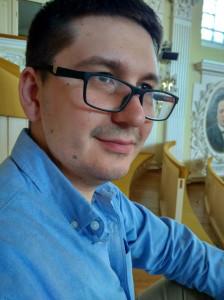© 2018 Sergei Shevchenko
2018 — №1 (15)
 Key words: translational medicine, anomalies, semantics, sociotechnical situation, legitimation and diffusion, multiplicity, technoscience, ‘from bench to bedside’.
Key words: translational medicine, anomalies, semantics, sociotechnical situation, legitimation and diffusion, multiplicity, technoscience, ‘from bench to bedside’.
Abstract: The article suggests a model of translational medicine which is seen as one of the main areas of technoscience. Translation, that is the path of artifacts, knowledge and practices from bench to bedside, involves a combination of legitimation and reproduction (diffusion) of a new class of sociotechnical situations. A sociotechnical situation is understood as a combination of two elements: a certain class of problems recognized as a legitimate part of biomedicine, and a certain class of artifacts (products of technological activity) that can be used for solution of these problems. In the meantime, a new class of artifacts can be legitimized for solution of a “stabilized” class of problems; for instance, when a new pharmaceutical preparation gets licensed for the treatment of a condition recognized by the biomedical community. On the other hand, a new class of problems can be legitimized where a well-known artifact of technoscience is applicable.In the most general form, translation is a co-tuning of the two components of the sociotechnical situations (problems and means to solve them). Complexity and multidimensionality of the co-tuning process (mutual legitimation of the artifact and the problem) can serve as one of the benchmarks for explaining the long duration of the translation processes. At the same time, both components of the sociotechnical situation produce two sides of the semantics of artifact, defining its identity, as well as the pragmatics of its use. The field of social practices – including research and engineering –that lead to the formation of semantics of an artifact during its translation is called semantic politics. The meaning of this term can be viewed as an extended interpretation of Annemarie Mol’s ‘ontological politics’.
As a rule, in social studies of translational medicine, the time of translation (“time lag”) and the proportion of successfully implemented technologies are considered as critical parameters of the translation of scientific and technical developments into clinical practice. At the same time, scientific facts and technological artifacts are often understood as invariable “data packets” or rigid sets of tools and methods that travel through the communicative network of laboratories, clinics, universities, health regulators (Morris, Wooding et al. 2011). However, making their way from the laboratory table to the bed of a patient (from bench to bedside), many facts and artifacts undergo significant transformations. Actually, the ability to reformulate facts and the ability to structure and semantically transform or tune artifacts is a criterion of a successful technology project.
Imagine that Viagra (sildenafil citrate) was developed and first applied not in 1992 in the UK, but 12 years earlier in the Soviet Union. Supposedly, sildenafil citrate was designed for treatment of pulmonary hypertension, and had some positive effect on this condition; therefore it was approved for the use in patients with this disease. Data about anomalies – positive side effects on erection – were discussed unofficially, but could not lead to legitimation of sildenafil citrate for the treatment of erectile disfunction, because this condition was hardly recognized as a disease.
So in order for a certain class of medical problems to be legitimized (as a variant of translation process) there should be: 1. Means of collecting data about a wide range of anomalies during the implementation of a new method or use of a new artifact; 2a) Intention of professional groups to legitimate a new class of problems and understanding of what class of problems can be legitimized; 2b) Possibility to legitimize the class of problems in certain political (social, economic) circumstances.
The other type of legitimation of technoscientific innovations imply the tuning of artifacts for solution of a stable class of problems. Generally, the translation process (as a combination of legitimation and reproduction of a new class of technoscientific situations) includes both types of legitimation.
Notes:
* – The reported study was funded by the Russian Foundation of Fundamental Studies, research project № 18-311-00315.
References
Ashburn T.T., Thor K.B. (2004) Drug repositioning: identifying and developing new uses for existing drugs, Nature Reviews. Drug Discovery, No. 3 (8), p. 673–83.
Broder S., Cushing M. (1993) Trends in program project grant funding at the national cancer institute,Cancer Research, No. 53, p. 477–484.
Chalmers, D.J. (2000) The Foundations of Two-Dimensional Semantics. M. Garcia-Carpintero and J. Macia (eds.), Two-Dimensional Semantics: Foundations and Applications, Oxford University Press, p. 55-140.
Geroski P.A. (2000) Models of technology diffusion, Research Policy, Iss. 29, p. 603–625.
Kuhn T. (2003)Struktura nauchnyh revolyucij. [The Structure of Scientific Revolutions; Russian translation], Moscow, AST.
Mol A. (1999) Ontological politics. A word and some questions, The Sociological Review, No. 47, p. 74–89.
Morris Z.S. Wooding S., Grant J. (2011) The answer is 17 years, what is the question: understanding time lags in translational research, Journal of the Royal Society of Medicine, No. 104, p. 510-520.
Putnam H. (1975) Is Semantics Possible? Metaphilosophy,No. 1 (3), p. 187–201.
Van der Laan A.L., Boenink M. (2015) Beyond Bench and Bedside: Disentangling the Concept of Translational Research, Health Care Analysis, No. 23, p. 32-49.
Wang R.C., Jiang F.M., Zheng Q.L., Li C.T., Peng X.Y., He C.Y., Luo J., Liang Z.A. (2014) Efficacy and Safety of Sildenafil Treatment in Pulmonary Arterial Hypertension: a Systematic Review, Respiratory Medicine, Vol. 108 No.3, p. 513–517.